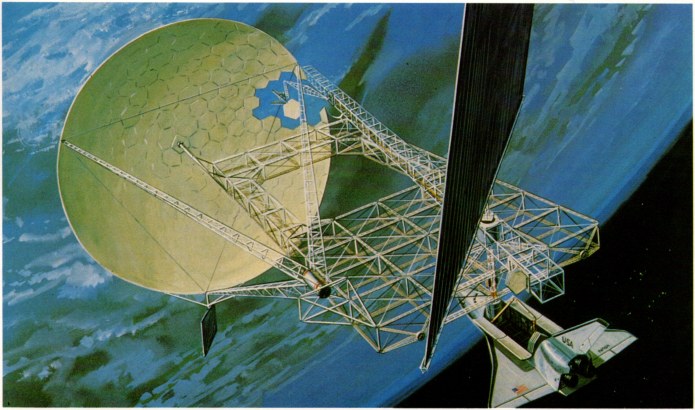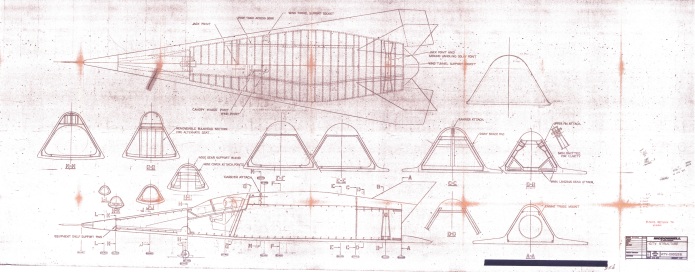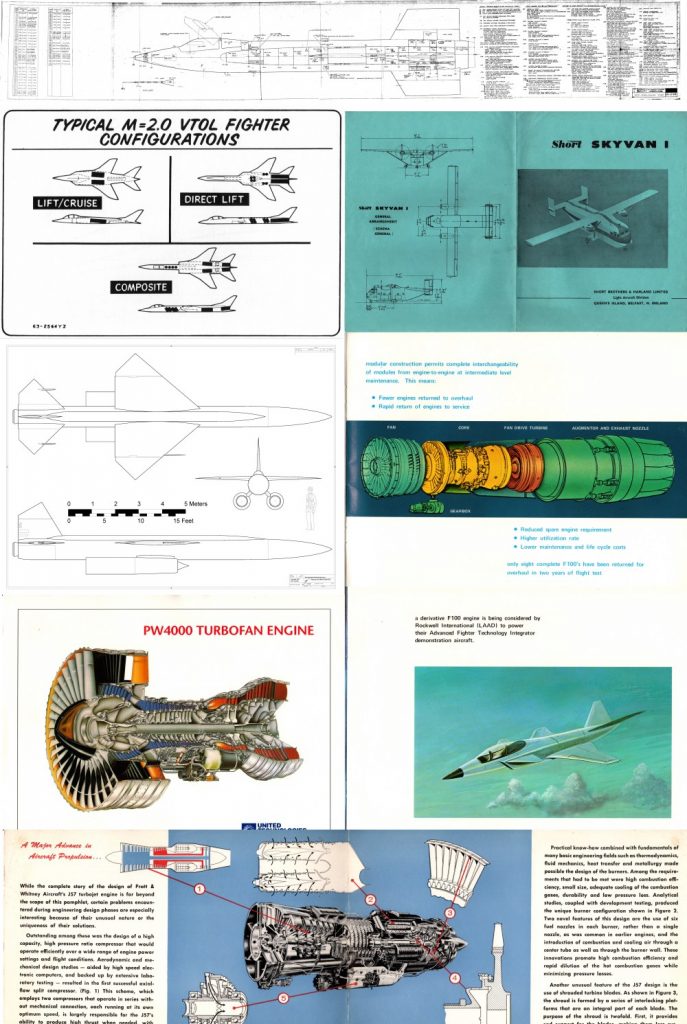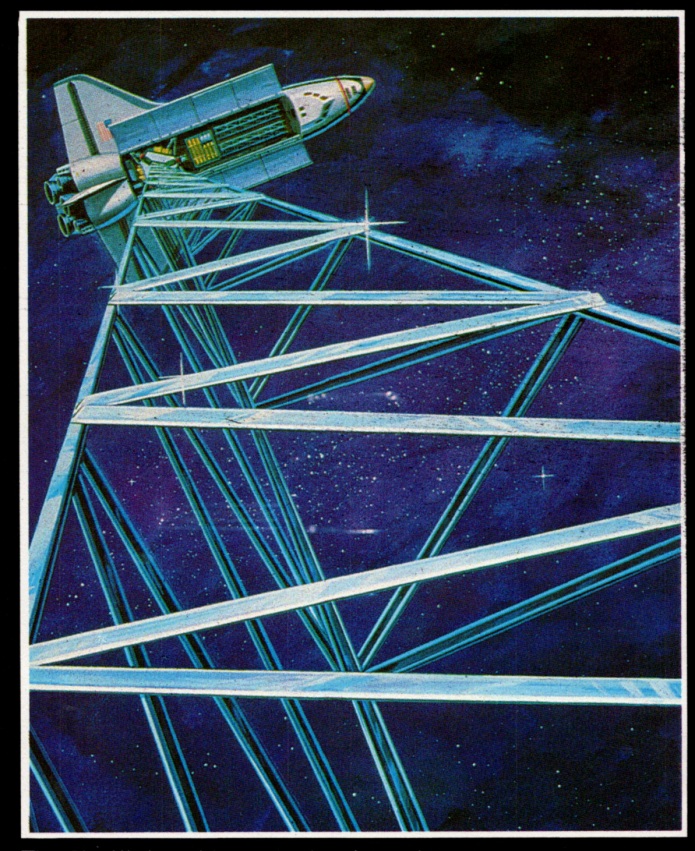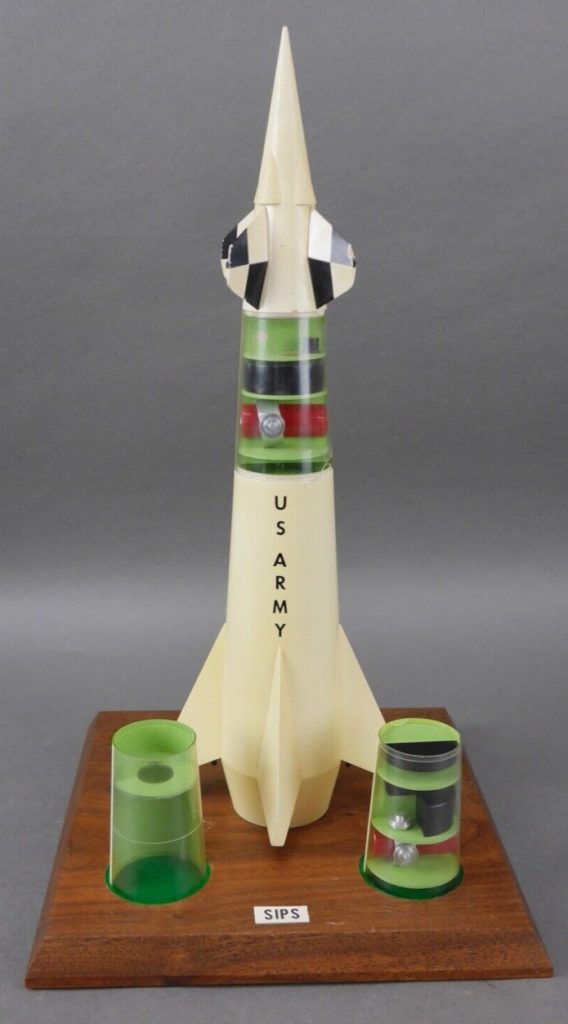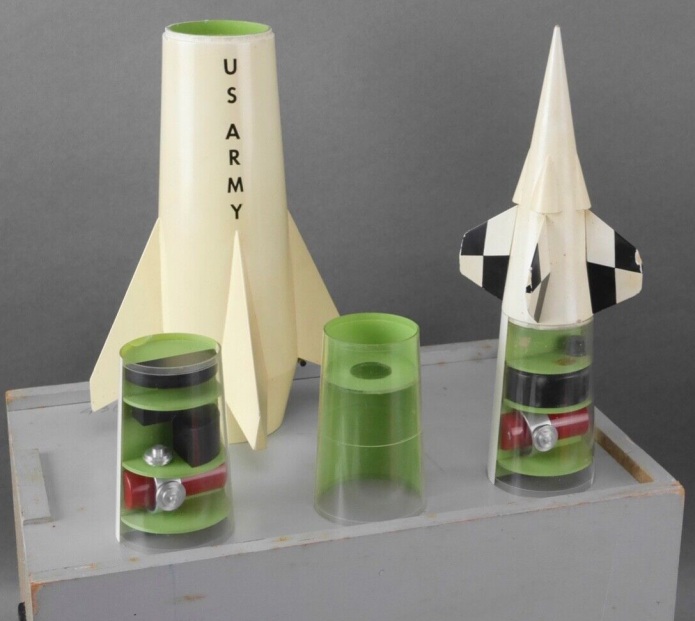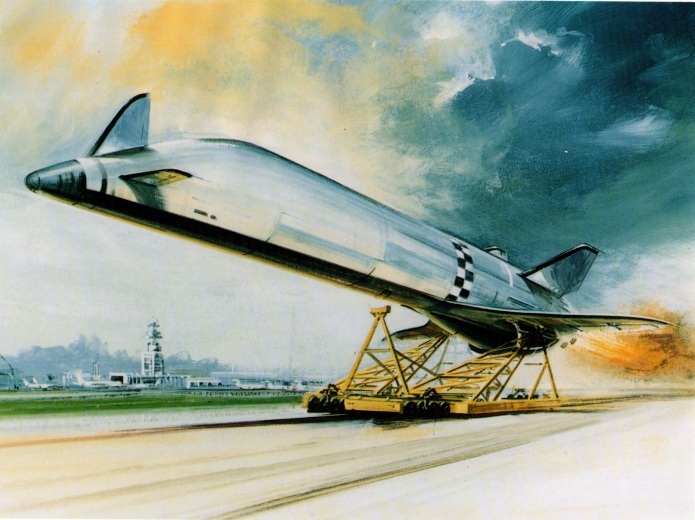A piece of artwork attributed to the DoD (1984 or before) depicting a large structure being built in space. Since it’s DoD, it is most likely a surveillance or mapping radar system of some kind, or an electronic listening system. Since it doesn’t seem to have either large PV arrays or a nuclear reactor – at least not yet at this stage in construction – I’d lean towards it being a listening system. Of course, a great deal more stuff may have been added to it after this… assuming it’s an actual design and not pure art.
Recently APR Patrons/Subscribers and I were able to successfully crowdfund the purchase of a lot off ebay that included a few folders of vintage lifting body work. The chief prize from the lot was a *giant* blueprint of a “GTV Structure,” a manned Model 176/ FDL-7 lifting body test vehicle (“GTV” was not explained, but I suspect it means something like “Glide Test Vehicle,” designed to be dropped from an NB-52). Scanning of the lot is underway; the crowdfunders now have access to the blueprint in several forms (full size, halfsize; full color, grayscale).
If you would like to help fund the acquisition and preservation of such things, please consider signing on either for the APR Patreon or the APR Monthly Historical Documents Program.
I’ve just made the June 2022 rewards available for APR Patrons and Subscribers. This latest package includes:
Large format diagram: “X-15 Access Doors.” A North American Aviation diagram from 1956 showing all the openable panels on the port (left) side of the fuselage
Document: “Harpoon Coastal Defense System:” McDonnell Douglas brochure on a truck-launched anti-ship missile
Document: “Harpoon for Fast Patrol Boats:” McDonnell Douglas brochure on anti-ship missiles for small ships
Document: “Shorts Skyvan:” small brochure about the boxy cargo aircraft
Document: “VTOL Design – Turbojet Configurations” Northrop paper on VTOL fighters, mostly a historical review but with basic layouts for designs up to Mach 3
Document: Turbofan propaganda. A number of brochures and data sheets and such on turbofans and turbojets… PW4000, F100, JT9D-7R4, J57.
CAD diagram ($5 and up): IM-99B BOMARC surface to air missile general arrangement
If you would like to help fund the acquisition and preservation of such things, along with getting high quality scans for yourself, please consider signing on either for the APR Patreon or the APR Monthly Historical Documents Program. Back issues are available for purchase by patrons and subscribers.
Clearing out the “videos to shove onto YouTube” folder, here’s a cell phone video I shot of the QM-1 test firing back in 2015. It’s got all the production quality you could expect from someone just holding a phone. And did I miss the ignition? Yes I did.
Here’s another video of mine of the same test, shot with a DSLR camera with a telephoto lens and a tripod. Posted this back when it happened, seven years ago:
Prior to Challenger, one piece of technology that was often touted as something that would be deployed by the Space Shuttle was the “beam builder.” This was a mechanism that would take rolls of aluminum “tape” a millimeter or less in thickness and automatically chop, bend, deploy and weld said aluminum into truss structure beams. These beams would be arbitrarily long… useful for building all manner of things, from space stations to radar satellites, on up to solar power satellites. The technology got fairly far along… but once Challenger exploded, the idea of actually using the shuttle to build vast constructs in space kinda vanished, with ISS being the only example of that. And in the case of ISS, very little actual “construction” was carried out, instead the ISS was simply assembled, with parts like the solar panels deploying rather than being built.
But while it lasted, beam builders featured in a lot of concept art, such as the one below depicting a beam being extruded from the Beam Builder in the rear of the Shuttle cargo bay. Irritatingly, I’ve misplaced the book I scanned this from and cannot immediately confirm who to credit it to.
A Russian surface to air missile recently failed rather spectacularly, turning around quickly in flight and seemingly tried to go home.
Additional angle pic.twitter.com/YYaGoGiH9M
— OSINTtechnical (@Osinttechnical) June 24, 2022
This sort of thing is not terribly unusual. Here’s a Saudi Patriot missile taking a detour:
Extremely high velocities, perspectives and vast distances can be a hard thing to grasp… but this REALLY scarily puts the velocities of missiles and rockets into perspective! 😳🤯 this is a Saudi Patriot missile failure 😱 genuinely terrifying! (source unknown) pic.twitter.com/8ucrfkuGRh
— Everyday Astronaut (@Erdayastronaut) October 12, 2019
A feller in Denmark is making a twenty-five foot long model of the “Eagle transporter” from “Space: 1999.” There is some *serious* commitment to cause here, as photographically documented on his website.
No, I’m not jealous. YOU’RE jealous.
Recently sold on eBay was a display model for a vehicle labeled “SIPS.” No other data was available. However, this appears to be an upper stage modification for the LIM-49 Spartan surface-to-air anti-missile missile. Which suggests that the first “S” in “SIPS” standard for “Spartan.” Perhaps something like “Spartan Integral Propulsion System” or some such. However, this seems to appear to be a complete vehicle…. the very large first and second stage motors, as well as the warhead section, *appear* to have been replaced with a new, small booster with fins. Perhaps this was meant to test the third stage of the Spartan… or perhaps it was meant to be a way to find some use for the Spartan third stage after program cancellation, as some sort of scientific test vehicle.
The other photos from the ebay auction have been uploaded to the 2022-06 APR Extras folder on Dropbox for Patrons and Subscribers.
The diagram below shows the complete Spartan missile.

HOTOL (HOrizontal Take Off and Landing) was a British Aerospace concept for a single stage to orbit airbreathing launch vehicle, originating in the mid 1980’s. It was a stellar example of aerospace optimism; like its contemporary the X-30 National Aerospace Plane, it relied on a propulsion system of spectacular complexity and stunning lack-of-actual-existence to function. As originally conceived it was supposed to have an RB545 engine; unlike the X-30’s scramjet engine, the RB545 was an air breathing rocket engine. Liquid hydrogen would be used to liquify incoming air, a portion of which would be turbine-fed into rocket engines to burn with the hydrogen. Due to some amazing bureaucracy, the engine was slapped with the “Official Secrets Act” which meant that it was so amazing that it had to be classified… so classified that it basically couldn’t be worked on. Genius! Whether it would have actually worked any better than NASP’s scramjet is anyone’s guess. In the going on forty years since the RB545 was dreamed up, it obviously hasn’t driven an aircraft to orbit. Or, it seems, off a runway. Like the scramjet, it *might* work, if only the development effort was properly funded and allowed to work through issues, rather than starved and throttled.
The early HOTOL configuration shown here would have taken off using a ground trolley in order to save on landing gear mass. The vehicle was nominally unmanned, though crew and passengers could be installed in a module in the cargo bay, located well aft. One problem the configuration had was substantial center of gravity and center of pressure issues, driven by the long, slim fuselage filled with sloshing and emptying hydrogen tanks. As memory serves, this remained a problem throughout the design lifetime of HOTOL.
The full rez scan of this artwork has been uploaded to the 2022-06 APR Extras folder on Dropbox for APR Patrons and Subscribers.
